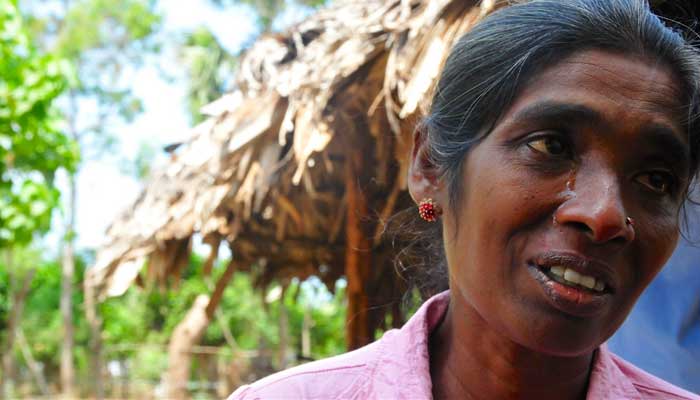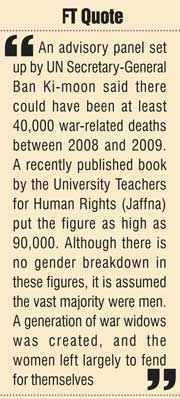Sunday Jan 19, 2025
Sunday Jan 19, 2025
Saturday, 16 May 2015 00:00 - - {{hitsCtrl.values.hits}}

Kulasekran Kugamathi has been searching for her husband and eldest son since the end of the civil war in Sri Lanka. The total number of people killed and missing as a result of the conflict is still unknown and remains a highly sensitive issue – Pic by Amantha Perera/IRIN
By Amantha Perera
IRIN: Almost six years after Sri Lanka’s bloody civil conflict came to an end, an underreported legacy of the fighting is finally being acknowledged: the extraordinarily high number of war widows struggling to make ends meet.
Sri Lanka’s new Government, led by President Maithripala Sirisena, estimated last month that Northern Province, which bore the brunt of the three decades of conflict, has an astonishing 50,000 families headed by single women.
It is the first time anyone has attached a figure to the phenomenon and it could have profound implications for Government policy.
“It has remained a huge problem since the end of the war,” said Roopavathi Ketheeswaran, the top public official in Kilinochchi District, which forms part of Northern Province and used to be the stronghold of the Tamil Tiger rebels. “(It is) a problem that had gone largely unaddressed because of lack of resources.”
Yogeshwari Ramalingam, a 39-year-old widow from neighbouring Mullaitivu District, is trying to put her three children — aged eight to 14 – through school. But it is tough going.
“During the war, my husband went missing,” she told IRIN. “He went looking for food and never came back. Since then I have been struggling.”
Peace as scary as war
The family home was hit by shelling during the war, but Ramalingam can’t afford to rebuild it. When she returned to her village in 2011, she received around $189 from the UN refugee agency, UNHCR. It was meant to help the family resettle, but after spending about $50 on roofing materials and the rest on food, the money was soon gone.
Since then, Ramalingam has been surviving by doing odd jobs in the village and traveling 20 kilometres out to work in the paddy fields during rice harvesting seasons. She was given some vocational training in embroidery by a local, church-based NGO, but has been unable to use her new skills because of the lack of employment opportunities.
“It has been hard, very hard. I thought the war was the nightmare. Peace has been equally scary.”
New approach
The Government, which took office in January, has signalled a new approach to addressing the divisive issues that still linger, long after the end of the civil war, including the parlous situation facing women in war-ravaged Northern Province.
At least one in five families in the north is led by a woman with no husband, according to official estimates.
The Government has already announced the establishment of a national centre in Kilinochchi to look after the needs of such families and has now introduced low interest loans of up to $260 specifically for these women. “This is the first time such a centre has been set up, so now we can look at this unique group and provide targeted assistance,” Ketheeswaran said, adding that the biggest problem was lack of jobs. To that end, “we will also provide tailor-made vocational training,” she said. There have been very few programmes designed to help the war widows to date. Since the start of 2013, the International Committee of the Red Cross has provided 435 women with funds of up to $378 to start new businesses. While the grants are welcome, that number represents only a small fraction of those needing help.
No jobs
While the national unemployment rate for women is 6.6%, “the unemployment rates among females are higher in the north,” said Muttukrishna Sarvananthan, author of a research paper on the issue due to be published in June. Female unemployment rates in the five districts that make up the Northern Province are 10.9% in Jaffna, 29.4% in Kilinochchi, 21.6% in Mannar, 20.5% in Mullaitivu and 9.0% in Vavuniya.
The districts with the highest figures – above 20% – are those where the fighting was fiercest. By comparison, the unemployment rate for women in Colombo is 3.2%, 7.0% in Galle and 6.8% in Kandy.
“The Government could give priority for single female heads of families in recruitment to the public sector,” Sarvananthan suggested.
Social workers in the north say that poverty forces many women to leave their potentially vulnerable children behind as they seek jobs further and further away from their villages.
“There are children dropping out of school. There are frequent cases of child abuse. There is also underlying trauma that has not been treated,” said Saroja Sivachandran, who heads the Jaffna-based Centre for Women and Development, which provides vocational training.
There have also been cases of women resorting to prostitution, though no official figures are available.
Numbers unknown
For a long time after the war, the plight of war widows was a taboo subject because it was linked to the sensitive issue of those still missing or unaccounted for, Sivachandran said.
The Sri Lankan Government has never confirmed the number of deaths during the final and deadliest phase of the war.
An advisory panel set up by UN Secretary-General Ban Ki-moon said there could have been at least 40,000 war-related deaths between 2008 and 2009. A recently published book by the University Teachers for Human Rights (Jaffna) put the figure as high as 90,000.
Although there is no gender breakdown in these figures, it is assumed the vast majority were men. A generation of war widows was created, and the women left largely to fend for themselves.